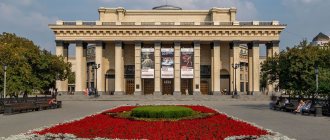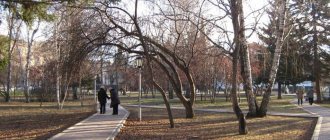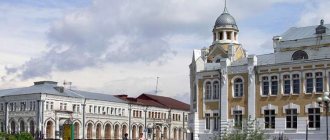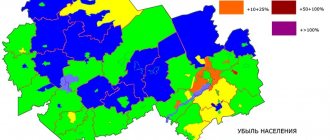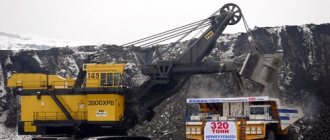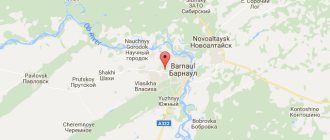Barabinsk
Village near Kainsk-Tomsky station
Translated from the Tatar language, the word “baraba” means “high water”. The city owes its birth and development to the construction of the Trans-Siberian Railway. At the Kainsk-Tomsky station there was a small village that grew out of a temporary settlement in which railway builders lived. This village appeared here at the end of the 19th century during the construction of the West Siberian Railway. On the site of the present city of Barabinsk there were lands of peasants who lived in the village of Novo-Chernovaya. The archives of the Barabinsky district contain a plan for 1900. The plan shows that a small area of peasant land was taken into the state treasury. The railway and Kainsk station were built on this land.
On the territory allocated for the village, there were 2 lakes - Bugristoye and Lebyazhye. Also here was part of Lake Boinsky. In the north-west there were pasture lands that belonged to the city of Kainsk. The plan of the new settlement indicates that Kainsk initially developed in a northeast direction. Construction was not limited to laying a railway line. The new station was intended for third class passengers. The building was wooden, but built on a stone foundation. Over time, accommodations for second class passengers appeared here. Near the station there was a locomotive depot and repair shops. In 1897, the station village had about two thousand inhabitants.
Reviews from contemporaries indicate that the station building was too cramped. Due to numerous complaints from passengers, the authorities were forced to begin construction of a new building in 1898. By 1903, a new brick station building was built. After the construction of the station was completed, it was decided to build a temple in honor of Andrew Stratelates and the Great Martyr Catherine. Materials for construction were brought from the Urals. The temple was built with funds from the Alexander III Foundation and could simultaneously accommodate at least 450 worshipers. Construction cost the foundation 10 thousand rubles.
In 1905, railroad workers founded a society called the Public Assembly of Railroad Employees. A separate room was allocated for the meeting. Among the founders of this society were mainly representatives of the railway management. At a meeting of railway employees, a club was organized, led by a council of elders. The council of elders most often included local officials and merchants; doctors and teachers were less common. The local intelligentsia took an active part in the activities of the new club. Membership in the club was paid and included entrance and ongoing fees.
In 1897, a one-class parochial school appeared in the railway village, which, like the temple, was built with funds from the fund of Alexander III. Children of both sexes could attend school. In 1898, the school was named after John of Kronstadt. In the same year, the educational institution became a two-class school. There were more boys in school than girls. The annual income of a school teacher was 600 rubles. In 1899, evening classes were opened at the school, whose tasks included training depot workers. At the beginning of the twentieth century, a dormitory was built for evening class students. In 1903, evening classes were transferred to the disposal of the railway department. By 1916, there were already several elementary schools in the village. There were plans to open another school. However, the implementation of these plans was prevented by the war.
In the mid-1890s, 2 medical stations were created at the station. There was a pharmacy, a hospital with 10 beds, and an emergency room. The medical staff was represented by a doctor, two paramedics and a midwife.
In the 1910s, 2 brick factories were built in the village. One of them was located on the site of the modern House of Culture. The other was located where the furniture factory is today. Based on reviews that have survived to this day and preserved product samples, we can conclude that the bricks produced here are of high quality. A warehouse for the Nobel Brothers partnership was built in the village. The warehouse was located slightly east of the mill. The board of the partnership was located in the capital. In many Russian cities located along the railway tracks, there were Nobel Brothers warehouses. Products were delivered to warehouses in tanks. The Cain warehouse of the partnership was relatively small. Fuel oil, car oil, gasoline and some other petroleum products were stored here, stored in containers of 3 thousand poods. At the turn of the 19th and 20th centuries, running water appeared in the station village. It started from Lake Lebyazhye. The water tower was only demolished in 1971. A railway clinic was built in its place. The water pipeline was created primarily for the needs of the railway. Hydraulic taps were installed at the station to supply water to the locomotives. The water entering the locomotives was not subjected to any treatment.
The station village developed quickly. At the beginning of the twentieth century, it became an urban-type settlement, inhabited by at least four thousand people. In the “List of Populated Places of the Tomsk Province” for 1911, Barabinsk is listed as the village of Kainsk at the Siberian Railway station; it numbered 853 households. The population demanded improved living conditions. There were pressing questions about improving public order and water supply. Despite numerous petitions to the province, people's requests were never heard.
City of Barabinsk
In 1917, the station village near Kainsk finally became independent. It receives the status of a city without a district and the name - Barabinsk. At the same time, the organization of party groups began. A Council of Workers' Deputies was organized in the city. Since all the forces of the new government were thrown into the political structure of Barabinsk, most of the problems of the city residents were left unattended. In addition to the existing ones, new difficulties also appeared. The main problem was the shortage of food and non-food items. The townspeople begin to show dissatisfaction with the new government. There were indeed grounds for dissatisfaction. Instead of solving the pressing problems of the population, representatives of the Soviet government were busy renaming streets, giving them the names of famous revolutionary figures. However, it was also impossible to demand a total improvement in life from the Bolsheviks. There was devastation in the country, which no government could get rid of overnight.
Relations between the local population and the new government worsened every day. According to the Barabino press of that time, armed conflicts between city residents and government officials were not uncommon. One day, an angry crowd stoned the head of the local police station to death. When the White Guards came to the city, many Barabin residents rejoiced at the possibility of the return of the former government. The city was taken without a fight on May 26, 1918. But already on May 31, Barabinsk passed into the hands of the Red Guards. At the beginning of June, power in the city again returned to the White Guards, who stayed, this time, for a long time. In Barabinsk, the previous authorities are being restored. The return of Soviet power occurred only in 1919, on December 1.
In 1920, the center of the Barabinsky district was moved to Kainsk. Before that he was in Barabinsk. The transfer of the administrative center did not affect the development of the young city. Until 1941 it developed more than intensively. A communist cell was created in Barabinsk, which included 60 boys and girls of the city. The cell's meetings were held in the building of a former commercial club. At the same time, the Barabinsk office “Zagotkhleb” of the Gubernia Food Committee was created. Subordinate to the provincial food committee there were several procurement points: Mikhailovsky, Severny, Kuibyshevsky and others. At the main point in Barabinsk, 2 warehouses were built. Scales and grain cleaning equipment were installed in one of the warehouses. All products were tested for quality and only after that could be sent to the warehouse. Over time, dryers appeared and additional storage facilities were built. In the second half of the 1930s, an elevator with a capacity of 500 tons was built in the city. Even during the Great Patriotic War, transformations in the city did not stop. In 1942, a special grinding mill was put into operation. The mill's productivity was no less than 25 tons of grain. Thanks to this mill, Barabinsk and the surrounding settlements did not experience the famine that affected residents of other regions. The Barabinsky district was fully supplied with bread.
At the end of the 40s, construction of a new elevator began. The grain storage capacity was more than 15 thousand tons. The elevator was put into operation in 1954 and was named Barabinsky elevator. At the end of the 50s, a new enterprise appeared in the city - MUKZ (small universal feed mill). The productivity of the enterprise reached 60 tons per day. And shortly before the appearance of MUKZ, the SOB-32 grain dryer was built, which met all the requirements of the standards of those years. In the 70s, powerful hydraulic lifts were put into operation. At the same time, an automatic sampler was installed, which is still in use today. In 1980, reorganizations were carried out at the Barabinsky elevator. As a result, the elevator was reorganized into the Barabinsky feed mill. In those years, more than three hundred people worked at the plant. Most workers had higher or secondary education. The plant produced feed for animals and birds of all ages. The plant's products were supplied to the Far East, the Urals, the Far North and many other regions of the USSR.
With the beginning of perestroika, one of the main enterprises of the city is experiencing great financial difficulties. Demand for the products of the Barabinsk feed mill has fallen sharply. In those years, the enterprise was headed by S. Chernyshev. The plant now has its own mill and bakery. Thus, the enterprise provided 80% of the city’s residents with bread. S. Chernyshev, being a talented leader, was able to save the enterprise from closure and its workers from dismissal. Today's Barabinsky Feed Mill OJSC is one of the most stable enterprises in its region. In 2001, the company was awarded a Small Gold Medal and a diploma at the Cain Fair. The plant was awarded high awards for its high quality and wide range of products. In 2002, the plant was awarded the Big Gold Medal. In 2003, the company received a certificate of honor.
The railway, thanks to which the city was born, also developed. In the mid-50s, the section between the Chulymskaya and Barabinskaya stations was electrified. Then work began on electrification of the section between Tatarskaya and Barabinskaya stations. Thus, the Baraba branch of the railway was electrified in the shortest possible time. By 1957, a lifting repair shop for the railway depot was built.
The cultural and sports life of the city began its intensive development after the Second World War. In 1958, construction of a stadium began in the southern part of the city. Many city enterprises contributed to this construction. The stadium was equipped with several courts (city, basketball, volleyball, tennis).
General education institutions began to receive stable funding only in 2000. Major and current repairs are carried out regularly and with better quality. All city schools are equipped with computer classes. The necessary office equipment is also present in all educational institutions. In addition to six general education schools in Barabinsk, there is a cadet boarding school for children left without parental care, and a boarding school for children of railway workers. There are also additional education institutions in the city: the Center for Additional Education, the Children and Youth Sports School, the House of Children's Creativity and the Children's Music School.
Private advertisements in Barabinsk, Novosibirsk region and Russia
To add an advert
Barabinsk
TOWER Barabinsk, Kuibyshev, NSO. .. . . . 8-913-745-85-45
Novosibirsk
The company provides accounting services
Novosibirsk
I will provide assistance in obtaining an education
Novosibirsk
Bill of lading, invoice, cash receipts
123ru.net
- every minute news with a daily archive. Only here we have all the main news of the day without political censorship. “123 News” - absolutely all points of view, sober analysis, civilized debates and discussions without mutual accusations and insults. If you don’t like it, don’t want to hear it, don’t read it, read it, be mutually polite and correct in your statements. Remember that not everyone's point of view coincides with yours. Respect the opinions of others, even if you defend your views and your position. 123ru.net is a news observer. We do not impose our vision on you, we give you a snapshot of the events of the day without censorship and without cuts. News as it is—online with minute-by-minute archives for all cities and regions of Russia, Ukraine, Belarus and Abkhazia. 123ru.net - live news live! A quick search from 123ru.net is not only the opportunity to be the first to know, but also the advantage of reporting breaking news instantly in any language in the world and being heard right away. You can add your news at any moment - here.
